New Dimensions for Circularity on Campus—Framework for the Application of Circular Principles in Campus Development
Abstract
1. Introduction
1.1. Objective
- How the principles of circularity can be systematically applied in practice in area (and other) development and transformation of a campus;
- What conditions must be met to develop/redevelop a university campus in accordance with the principles of the circular economy.
1.2. Method
- The creation process—with the producer, supplier and builder/contractor;
- The design process—with the architect, designer and consultant;
- The development process, management and use—with client, owner, user and manager.
2. Building Blocks for a Circular Approach
2.1. Evolution of the Concept of the Circular Economy
2.2. The Circular Economy in the Spatial Sector
2.3. Circular Construction Production
2.4. Sustainability Visions in Campus Development
2.5. Knowledge Gap
3. Circularity Strategies
3.1. Systems Thinking and Life Cycles
3.2. Dimensions in Campus Development
3.3. Practical Explorations on Campus
4. Results
4.1. Framework for a Circular Campus: Systems Thinking as a Starting Point
4.2. Integral Policy at Strategic Level
4.3. Tactical and Operational Level Specification
5. Discussion and Conclusions
5.1. Discussion
5.2. Conclusions
5.3. Follow-Up Study
5.4. Recommendations for a Circular Campus
- Ensure a consistent policy and support from all departments by formulating an integral strategy for circularity. Make sure you also have an implementation plan.
- Further develop the proposed system into a useful instrument by specifying substantive requirements and concrete objectives for the tactical and operational level.
- Reduce complexity and make the subject of circularity accessible and understandable. Set clear priorities in the initial phase.
- Let go of the automatism of existing frameworks and create space and flexibility for a different approach in the development process.
- Think and work more in network contexts. To be able to close cycles at the local level, consciously establish links between development projects on campus at different scales and in different life cycles.
Supplementary Materials
Author Contributions
Funding
Conflicts of Interest
References
- Geissdoerfer, M.; Savaget, P.; Bocken, N.M.P.; Hultink, E.J. The Circular Economy—A new sustainability paradigm? J. Clean. Prod. 2017, 143, 757–768. [Google Scholar] [CrossRef]
- Leising, E.; Quist, J.; Bocken, N. Circular Economy in the building sector: Three cases and a collaboration tool. J. Clean. Prod. 2018, 176, 976–989. [Google Scholar] [CrossRef]
- Kirchherr, J.; Reike, D.; Hekkert, M. Conceptualizing the circular economy: An analysis of 114 definitions. Resour. Conserv. Recycl. 2017, 127, 221–232. [Google Scholar] [CrossRef]
- Ghisellini, P.; Cialani, C.; Ulgiati, S. A review on circular economy: The expected transition to a balanced interplay of environmental and economic systems. J. Clean. Prod. 2016, 114, 11–32. [Google Scholar] [CrossRef]
- Jonker, J.; Stegeman, H.; Faber, N. De Circulaire Economie—Denkbeelden, ontwikkelingen en business modellen. Work. Pap. 2018. [Google Scholar] [CrossRef]
- Pomponi, F.; Moncaster, A. Circular economy for the built environment: A research framework. J. Clean. Prod. 2017, 143, 710–718. [Google Scholar] [CrossRef]
- Braungart, M.; McDonough, W. Die Nächste Industrielle Revolution—Die Cradle to Cradle-Community, 3rd ed.; Europäische Verlagsanstalt: Hamburg, Germany, 2011; ISBN 9783863930059. [Google Scholar]
- Ganzevles, J.; Potting, J.; Hanemaaijer, A. Evaluatie Green Deals Circulaire Economie; PBL Planbureau voor de Leefomgeving: Den Haag, The Netherlands, 2016. [Google Scholar]
- Van Splunter, M. Circulair Bouwen Slopen: Ketenverkenning van de Bouw-En Sloopsector Cirkelregio Utrecht; Utrecht Sustainability Institute: Utrecht, The Netherlands, 2016. [Google Scholar]
- Meadows, D.H.M. The Limits to Growth. A Report for the Club of Rome’s Project on the Predicament of Mankind; Universe Books: New York, NY, USA, 1972. [Google Scholar]
- Braungart, M.; McDonough, W. Cradle to Cradle: Remaking the Way We Make Things; North Point Press: New York, NY, USA, 2002; ISBN 9780865475878. [Google Scholar]
- Ellen MacArthur Foundation. Towards the Circular Economy (Report); Ellen MacArthur Foundation: Cowes, UK, 2013; pp. 1–96. [Google Scholar]
- Brundtland, G.H. Our Common Future: Report of the World Commission on Environment and Development. Unit. Nations Comm. 1987, 4, 300. [Google Scholar] [CrossRef]
- Ruiz-Real, J.L.; Uribe-Toril, J.; De Pablo Valenciano, J.; Gázquez-Abad, J.C. Worldwide Research on Circular Economy and Environment: A Bibliometric Analysis. Int. J. Environ. Res. Public Health 2018, 15, 2699. [Google Scholar] [CrossRef] [PubMed]
- Bocken, N.M.P.; de Pauw, I.; Bakker, C.; van der Grinten, B. Product design and business model strategies for a circular economy. J. Ind. Prod. Eng. 2016, 33, 308–320. [Google Scholar] [CrossRef]
- Pauliuk, S. Critical appraisal of the circular economy standard BS 8001:2017 and a dashboard of quantitative system indicators for its implementation in organizations. Resour. Conserv. Recycl. 2018, 129, 81–92. [Google Scholar] [CrossRef]
- Preston, F. A Global Redesign? Shaping the Circular Economy. Energy Environ. Resour. Gov. 2012, 1–20. [Google Scholar] [CrossRef]
- Von Bertalanffy, L. General System Theory: Foundations, Development, Applications; George Braziller: New York, NY, USA, 1968. [Google Scholar]
- De Zeeuw, F. Zo Werkt Gebiedsontwikkeling; Delft University of Technology, Praktijkleerstoel Gebiedsontwikkeling: Delft, The Netherlands, 2017. [Google Scholar]
- Wientjes, R. Circulaire Economie Binnen de Ruimtelijke Ordening in Westas; Saxion Hogeschool: Deventer, The Netherlands, 2015; Available online: http://www.kennislabvoorurbanisme.nl/wp-content/uploads/Circulaire-Stad.pdf (accessed on 10 December 2017).
- Potting, J.; Hekkert, M.; Worrell, E.; Hanemaaijer, A. Circular Economy: Measuring Innovation in the Product Chain—Policy Report (2544); PBL Netherlands Environmental Assessment Agency: The Hague, The Netherlands, 2017. [Google Scholar]
- Kennedy, C.; Pincetl, S.; Bunje, P. The study of urban metabolism and its applications to urban planning and design. Environ. Pollut. 2011, 159, 1965–1973. [Google Scholar] [CrossRef] [PubMed]
- Boomen, T.; van den Frijters, E.; van Assen, S.; Broekman, M. (Eds.) Urban Challenges, Resilient Solutions. Design Thinking for the Future of Urban Regions; Trancity—Valiz: Amersfoort, The Netherlands, 2017; ISBN 9789492095336. [Google Scholar]
- Jelier, W.P.C. Het Concept Stedelijk Metabolisme: Verkenning van Het Concept ‘Stedelijk Metabolisme’ Met Het oog op de Bruikbaarheid ervan voor Duurzame Stedelijke Ontwikkeling. Master’s Thesis, Delft University of Technology, Delft, The Netherlands, 2011. [Google Scholar]
- Tjallingii, S.P. Ecopolis: Strategies for Ecologically Sound Urban Development. Landscape and Urban Planning; Backhuys Publishers: Leiden, The Netherlands, 1995. [Google Scholar]
- Rijksoverheid. Nederland Circulair in 2050. Government of The Netherlands. 2017. Available online: https://circulaireeconomienederland.nl/rijksbreed+programma+circulaire+economie/default.aspx (accessed on 3 March 2018).
- Schut, E.; Crielaard, M.; Mesman, M. Beleidsverkenning circulaire economie in de bouw. Rijkswaterstaat, Rijksinstituut voor Volksgezondheid en Milieu, The Netherlands. 2015. Available online: https://www.rivm.nl/bibliotheek/rapporten/2015-0197.pdf (accessed on 3 March 2018).
- Nederland Circulair. Meer dan helft alle grondstoffen verbruikt in bouwsector: Kansen voor circulair?—Nederland circulair. The Netherlands. 2016. Available online: https://www.circulairondernemen.nl/uitdagingen/meer-dan-helft-alle-grondstoffen-verbruikt-in-bouwsector-kansen-voor-circulair (accessed on 28 April 2018).
- Transitieteam Circulaire Bouweconomie. Transitie-Agenda Circulaire Bouweconomie. Government of The Netherlands, 2018. Available online: https://www.rijksoverheid.nl/documenten/rapporten/2018/01/15/bijlage-4-transitieagenda-bouw (accessed on 14 March 2018).
- Bastein, T.; Roelofs, E.; Rietveld, E.; Hoogendoorn, A. Kansen voor de Circulaire Economie in Nederland; TNO: Delft, The Netherlands, 2013; pp. 1–93. Available online: https://www.rijksoverheid.nl/documenten/rapporten/2013/06/20/tno-rapport-kansen-voor-de-circulaire-economie-in-nederland (accessed on 3 March 2018).
- Cramer, J. Strategische Verkenning ‘Op weg Naar Cirkelregio Utrecht’; Utrecht Sustainability Institute: Utrecht, The Netherlands, 2015. [Google Scholar]
- Bijleveld, M.M.; Bergsma, G.C.; Krutwagen, B.T.J.M.; Afman, M.A. Meten is Weten in de Nederlandse Bouw Milieu-Impacts van de Nederlandse Bouw-En Sloopactiviteiten in 2010; CE Delft/Bouwend Nederland: Delft, The Netherlands, 2015. [Google Scholar]
- IABR. Stedelijk Metabolisme, Duurzame Ontwikkeling van Rotterdam; IABR: Rotterdam, The Netherlands, 2014. [Google Scholar]
- Potemans, A. Modular Building in a Circular Economy. Master’s Thesis, Delft University of Technology, Delft, The Netherlands, 2017. [Google Scholar]
- Van Haagen, F.P.C. Circulair Aanbesteden—DNA-Match: Het Geheim Achter Een Spraakmakende Circulaire Aanbesteding. Master’s Thesis, Delft University of Technology, Delft, The Netherlands, 2018. [Google Scholar]
- Castelein, L. Circulair Contracteren: Een Onderzoek Naar De Huidige Mogelijkheden Voor Circulariteit in Bouwcontracten. Master’s Thesis, Delft University of Technology, Delft, The Netherlands, 2018. [Google Scholar]
- Ten Klooster, G. Op Weg Naar Circulair Bouwen en Slopen in Amersfoort; University of Twente: Enschede, The Netherlands, 2017; Volume 41, Available online: http://research.economicboardutrecht.nl/sites/nl.economicboardutrecht.research/files/Op weg naar circulair bouwen en slopen in Amersfoort.pdf (accessed on 24 January 2018).
- Lozano, R.; Ceulemans, K.; Alonso-Almeida, M.; Huisingh, D.; Lozano, F.J.; Waas, T.; Hugé, J. A review of commitment and implementation of sustainable development in higher education: Results from a worldwide survey. J. Clean. Prod. 2014, 108, 1–18. [Google Scholar] [CrossRef]
- De Vries, J. Presteren Door Vastgoed, Onderzoek Naar De Gevolgen Van Vastgoedingrepen Voor De Prestatie Van Hogescholen. Ph.D. Thesis, Delft University of Technology, Delft, The Netherlands, 2007. [Google Scholar]
- Verhoef, L.; Graamans, L.; Gioutsos, D.; Van Wijk, A.; Geraedts, J.; Hellinga, C. ShowHow: A Flexible, Structured Approach to Commit University Stakeholders to Sustainable Development. In Handbook of Theory and Practice of Sustainable Development in Higher Education; Filho, W.L., Azeiteiro, U.M., Molthan-Hill, F.A., Eds.; Springer: Berlin/Heidelberg, Germany, 2017; Volume 4, pp. 491–508. [Google Scholar] [CrossRef]
- Den Heijer, A.C. Managing the University Campus: Information to Support Real Estate Decisions. Ph.D. Thesis, Delft University of Technology, Delft, The Netherlands, 2011. [Google Scholar]
- Curvelo Magdaniel, F. Technology Campuses and Cities: A Study on the Relation Between Innovation and the Built Environment at the Urban Area Level. Ph.D. Thesis, Delft University of Technology, Delft, The Netherlands, 2016. [Google Scholar]
- Den Heijer, A.C.; Curvelo Magdaniel, F.T.J.C. The university campus as a knowledge city: Exploring models and strategic choices. Int. J. Knowl. Based Dev. 2012, 3, 283–304. [Google Scholar] [CrossRef]
- Ávila, L.V.; Leal Filho, W.; Brandli, L.; Macgregor, C.J.; Molthan-Hill, P.; Özuyar, P.G.; Moreira, R.M. Barriers to innovation and sustainability at universities around the world. J. Clean. Prod. 2017, 164, 1268–1278. [Google Scholar] [CrossRef]
- Den Heijer, A.C.; Arkesteijn, M.; de Jong, P.; de Bruyne, E. Campus NL—Investeren in de Toekomst (Report). Architecture, Management in the Built Environment; Delft University of Technology: Delft, The Netherlands, 2016; Available online: http://www.vsnu.nl/files/documents/Campus NL digital version (for websites).pdf (accessed on 4 January 2018).
- Den Heijer, A.C. Campus Wordt Duurzame Kennisstad: Het Delen van Ruimte als Positieve Keuze (Journal Article); Delft University of Technology: Delft, The Netherlands, 2011; Available online: https://repository.tudelft.nl/islandora/object/uuid%3Afb3b5dae-b452-4c37-8785-ca6fac75ee0b?collection=research (accessed on 21 February 2018).
- Circulaireeconomienederland. Available online: https://www.circulaireeconomienederland.nl/default.aspx (accessed on 26 November 2018).
- EEA. SOER 2015—The European Environment—State and Outlook 2015; European Environment Agency: Copenhagen, Denmark, 2015; Available online: https://www.eea.europa.eu/soer (accessed on 26 November 2018).
- Loorbach, D.A. To Transition! Governance Panarchy in the New Transformation; Erasmus University Rotterdam: Rotterdam, The Netherlands, 2014; ISBN 978-90-822881-0-0. [Google Scholar]
- De Graaf, R.S. Basisboek Systems Engineering in de Bouw: Een Methodische Totaalaanpak van Het Bouwproces; Brave New Books: Austin, TX, USA, 2014; Available online: https://research.utwente.nl/en/publications/basisboek-systems-engineering-in-de-bouw (accessed on 10 May 2018).
- Franzen, A.; Hobma, F.; de Jonge, H.; Wigmans, G. Management of Urban Development Processes. Governance, Design and Feasibility; Techne Press: Amsterdam, The Netherlands; Delft, The Netherlands, 2010; ISBN 9789085940296. [Google Scholar]
- Glaser, M.; Karssenberg, H.; Laven, J.; van Teeffelen, J.; van’t Hoff, M. The City at Eye Level. Lessons for Street Plinths; Eburon Academic Publishers: Delft, The Netherlands, 2016. [Google Scholar]
- Teisman, G.; Gerrits, L. The Emergence of Complexity in the Art and Science of Governance. Complex. Gov. Netw. 2014, 1, 7–28. [Google Scholar] [CrossRef]
- Klijn, E.H.; Steijn, B.; Edelenbos, J. The Impact of Network Management on Outcomes. Gov. Netw. Public Adm. 2010, 88, 1063–1082. [Google Scholar] [CrossRef]
- Nelissen, N.; de Goede, P.; van Twist, M. Oog voor Openbaar Bestuur; Elsevier Overheid: The Hague, The Netherlands, 2004; ISBN 9059014987. [Google Scholar]
- Daamen, T.A.; Verheul, W.J. Stedelijke ontwikkeling als een emergente adaptieve strategie. Bestuurswetenschappen 2014. [Google Scholar] [CrossRef]
- Hopff, B. De Stad en de Campus (Essay); MCD Erasmus University Rotterdam: Rotterdam, The Netherlands, 2017. [Google Scholar]
- Brand, S. How Buildings Learn: What Happens after They’re Built; Viking Press: New York, NY, USA, 1994. [Google Scholar]
- Zuidema, R. De Olifant Dendert Door de Circulaire Stad, 2nd ed.; Stichting BRIQS: Amsterdam, The Netherlands, 2017; ISBN 978-94-92383-67-9. [Google Scholar]
- Nijhuis, S.; de Vries, J.; Noortman, A. Ontwerpend onderzoek. In Praktijkgericht Onderzoek in de Ruimtelijke Planvorming; Simons, W., van Dorp, D., Eds.; Methoden voor analyse en visievorming; Uitgeverij Landwerk: Wageningen, The Netherlands, 2017; pp. 256–283. [Google Scholar]
- De Bruijn, H.; Ten Heuvelhof, E.; in’t Veld, R. Een Nadere Positionering van de Procesbenadering. Procesmanagement. Over Procesontwerp en Besluitvorming, 4th ed.; Boom Uitgevers: Amsterdam, The Netherlands, 2012; ISBN 978 90 5261 932 3. [Google Scholar]
- Teisman, G. Publiek Management op de Grens van Chaos en Orde (Public Management on the Border of Chaos and Order); Erasmus University Rotterdam: Rotterdam, The Netherlands, 2005. [Google Scholar]
- Loorbach, D.A. Transition Management for Sustainable Development: A Prescriptive, Complexity-Based. Governance 2010, 23, 161–183. [Google Scholar] [CrossRef]
- De Bruijn, J.A.; Ten Heuvelhof, E. Strategieën: Een vergelijking tussen projectmatige en procesmatige verandering. In Management in Netwerken; Boom Lemma Uitgevers: Utrecht, The Netherlands, 2007; pp. 75–109. ISBN 978 90 5931 013 1. [Google Scholar]
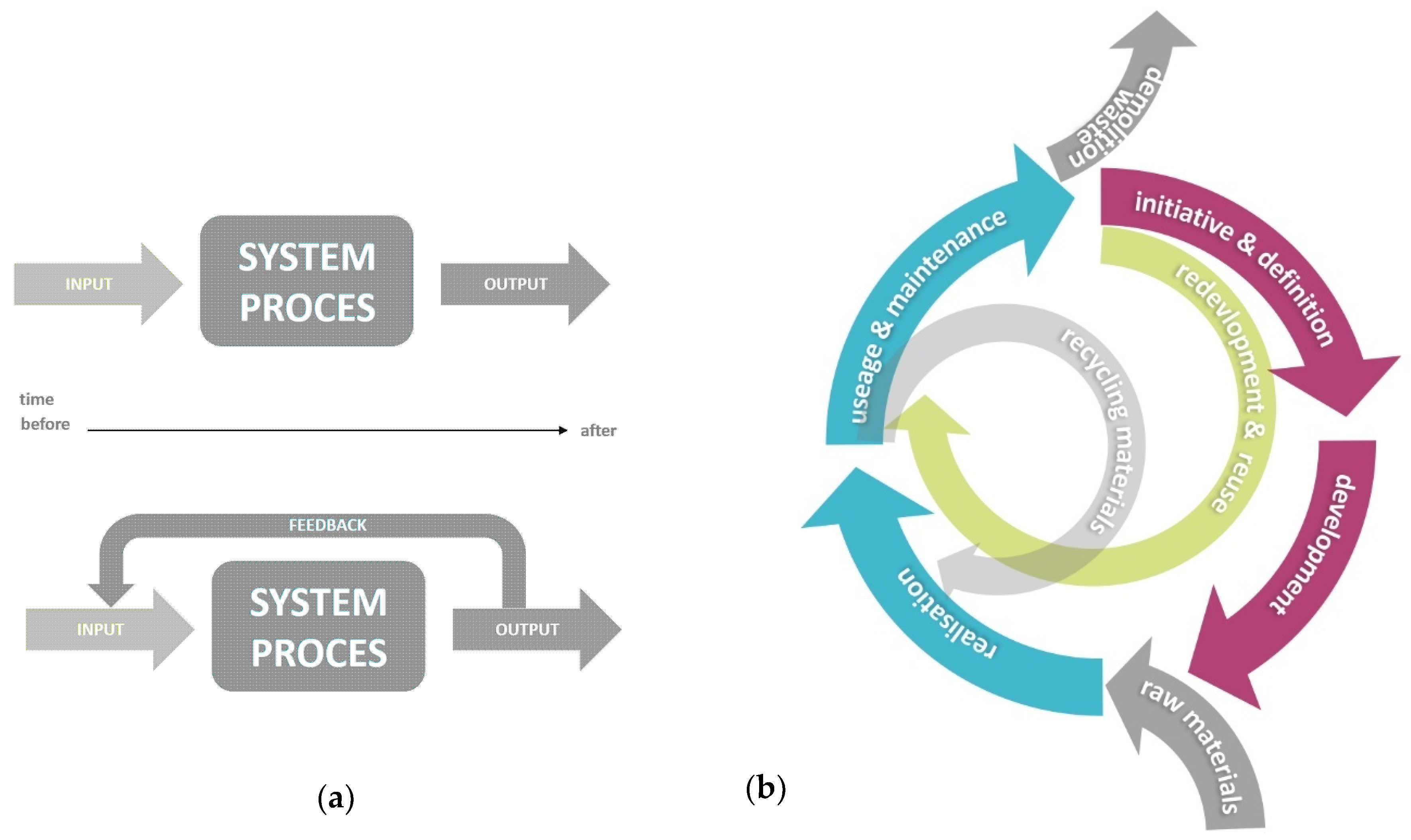
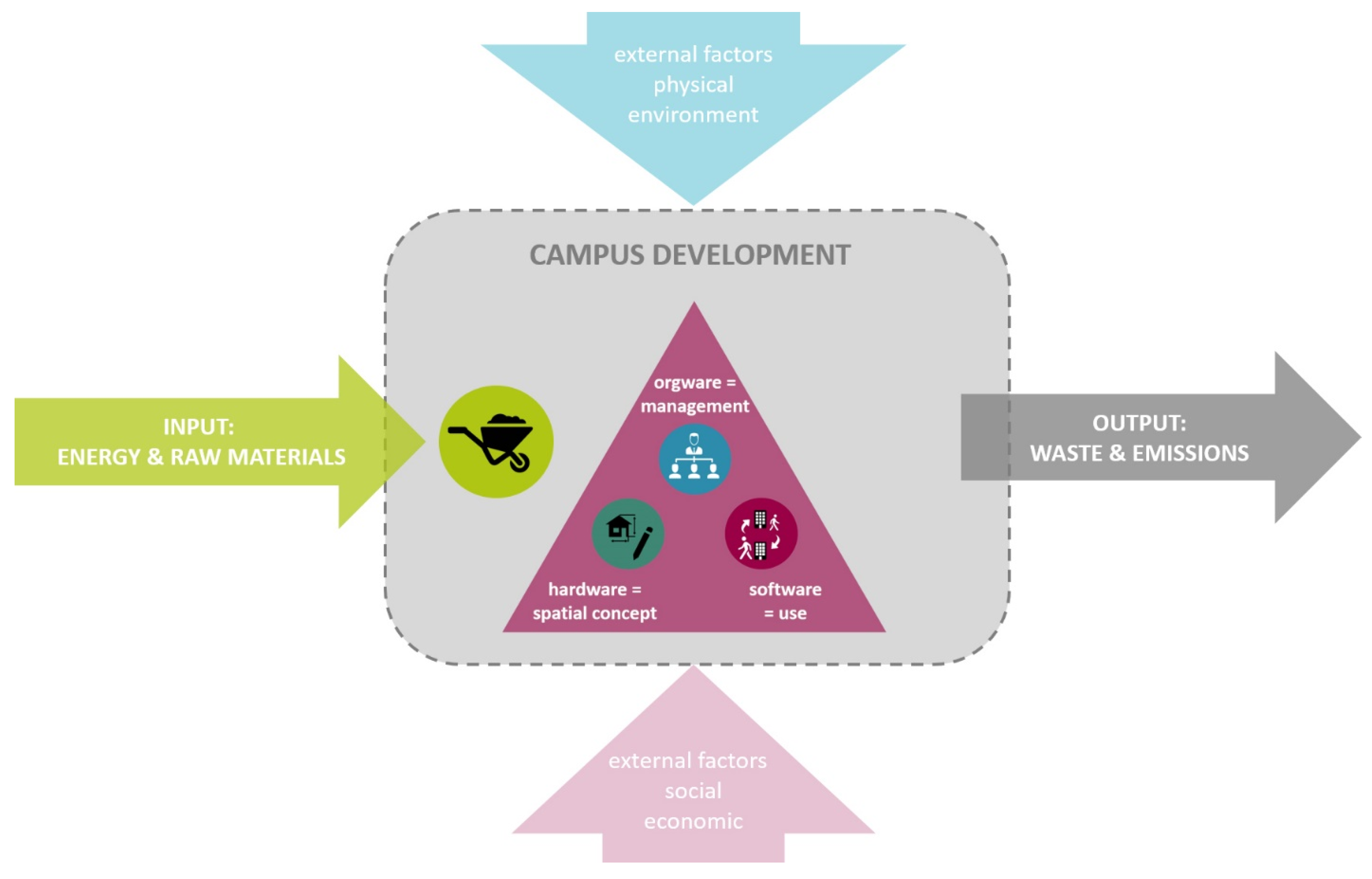
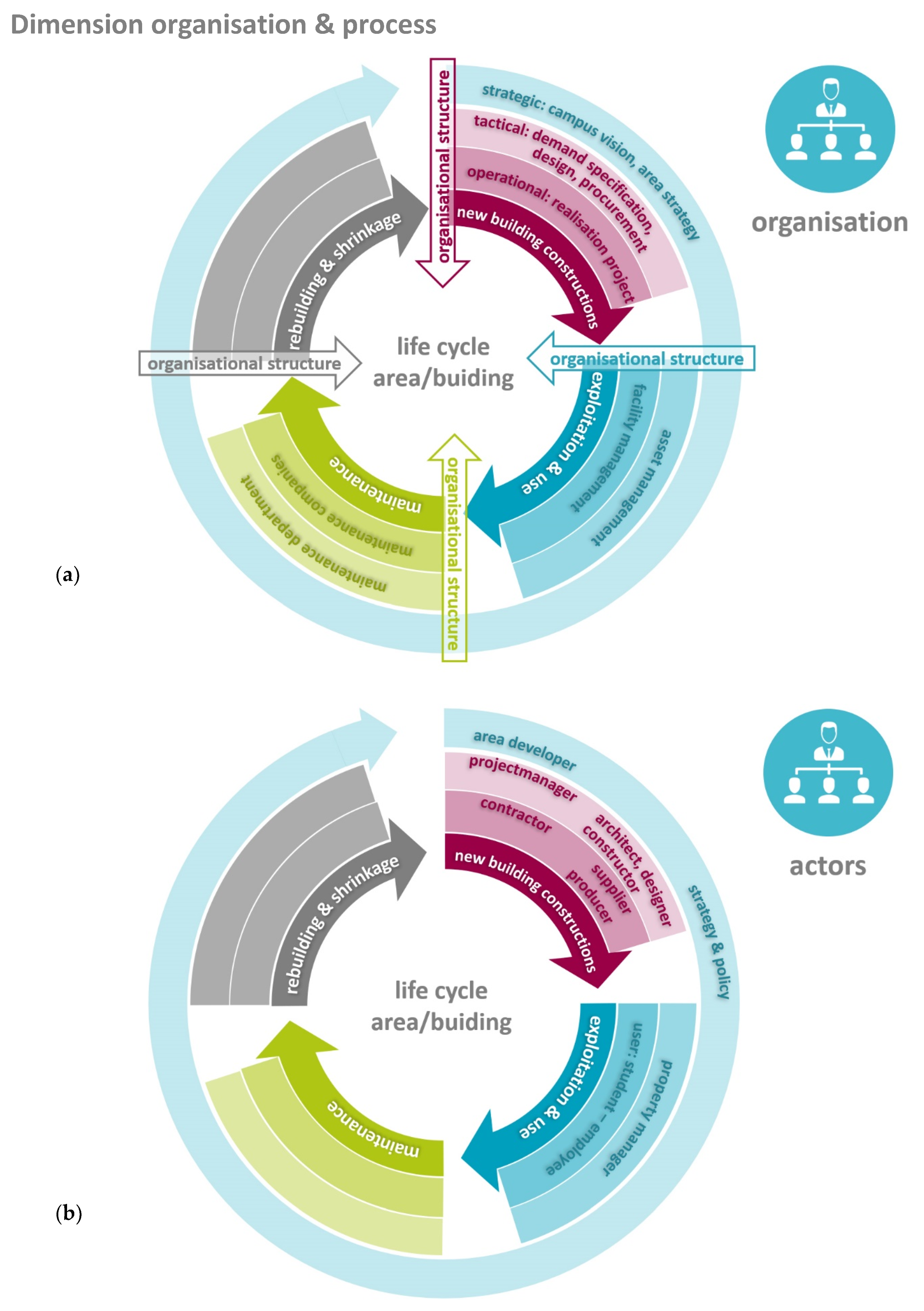
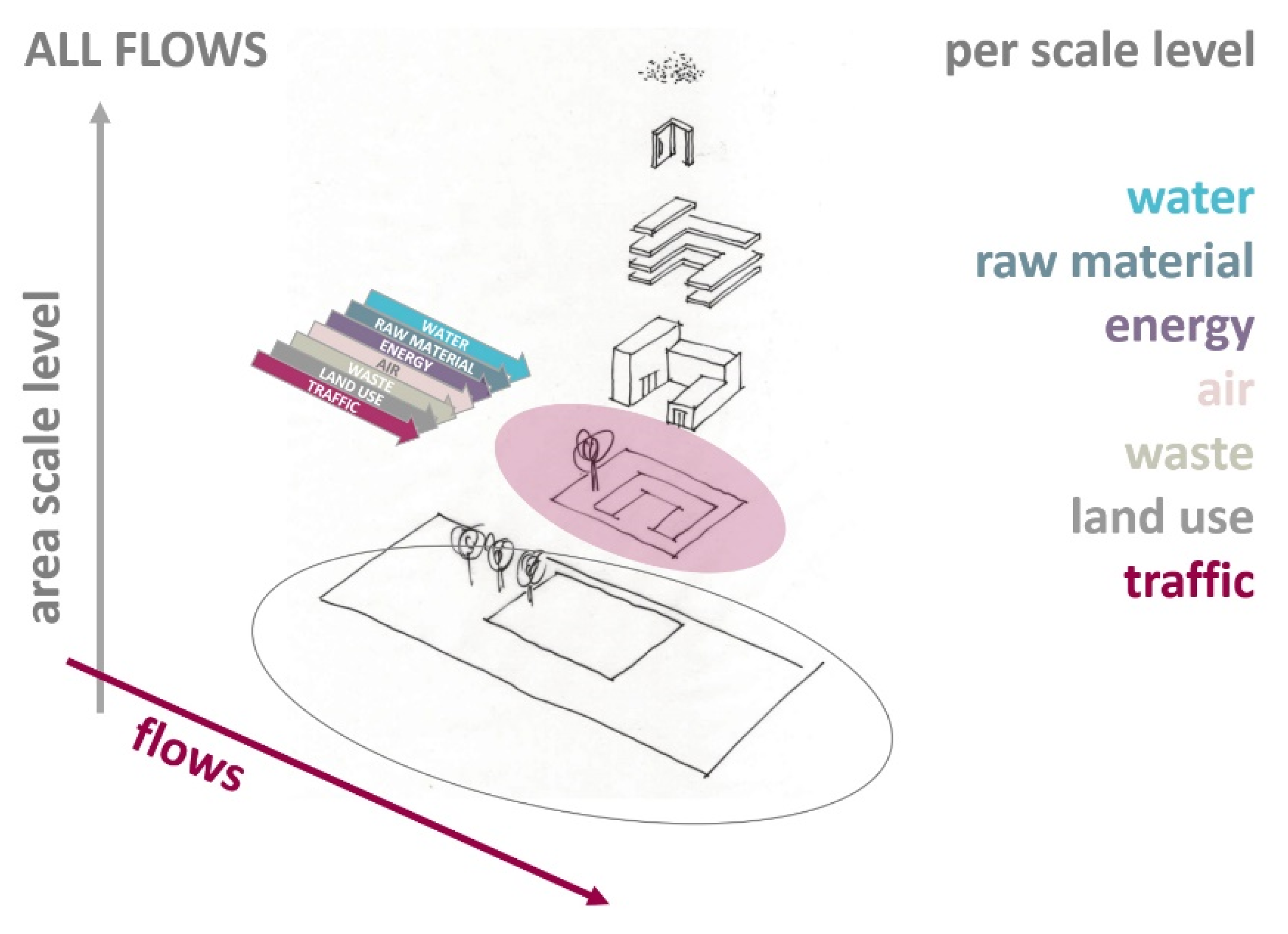
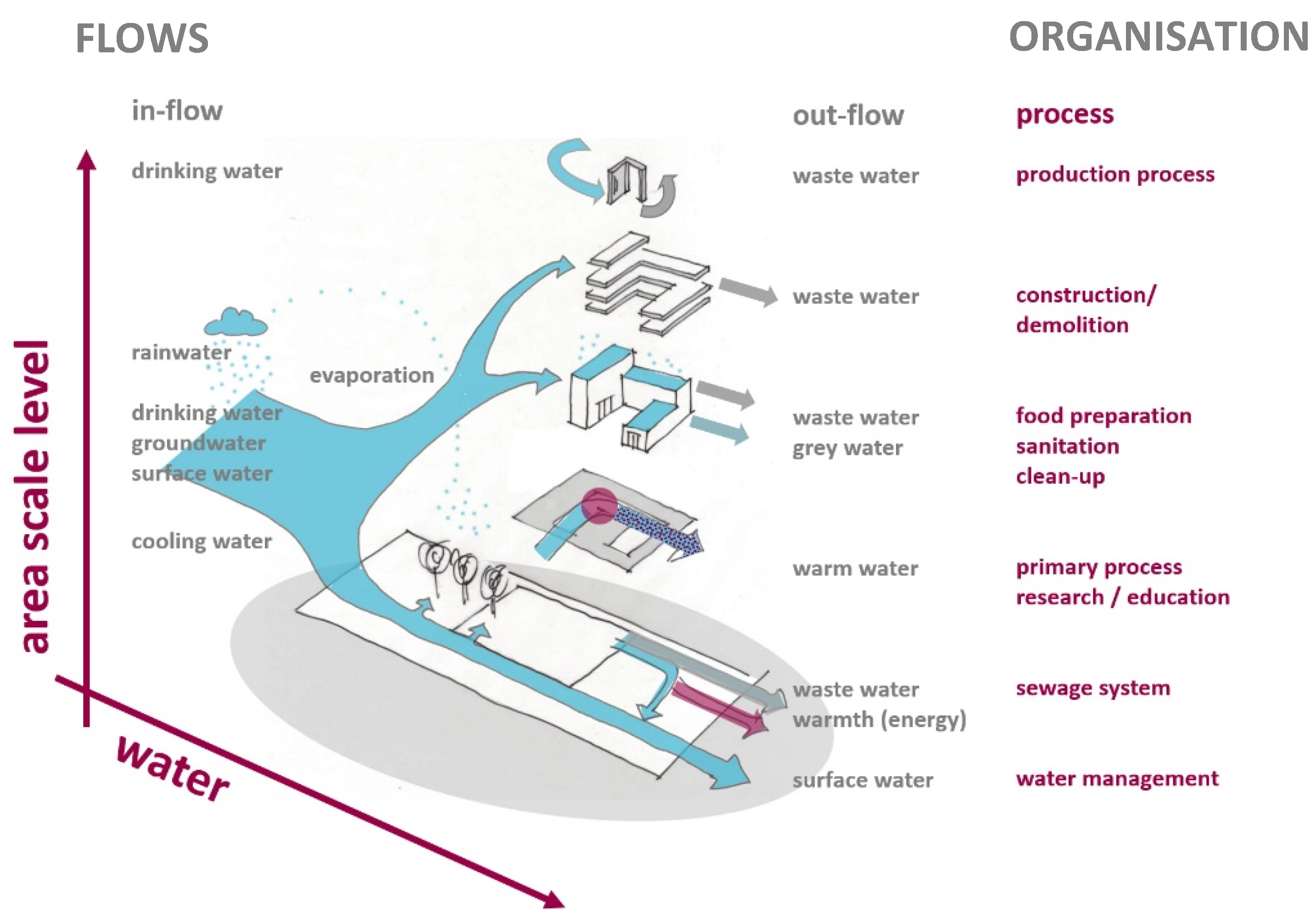
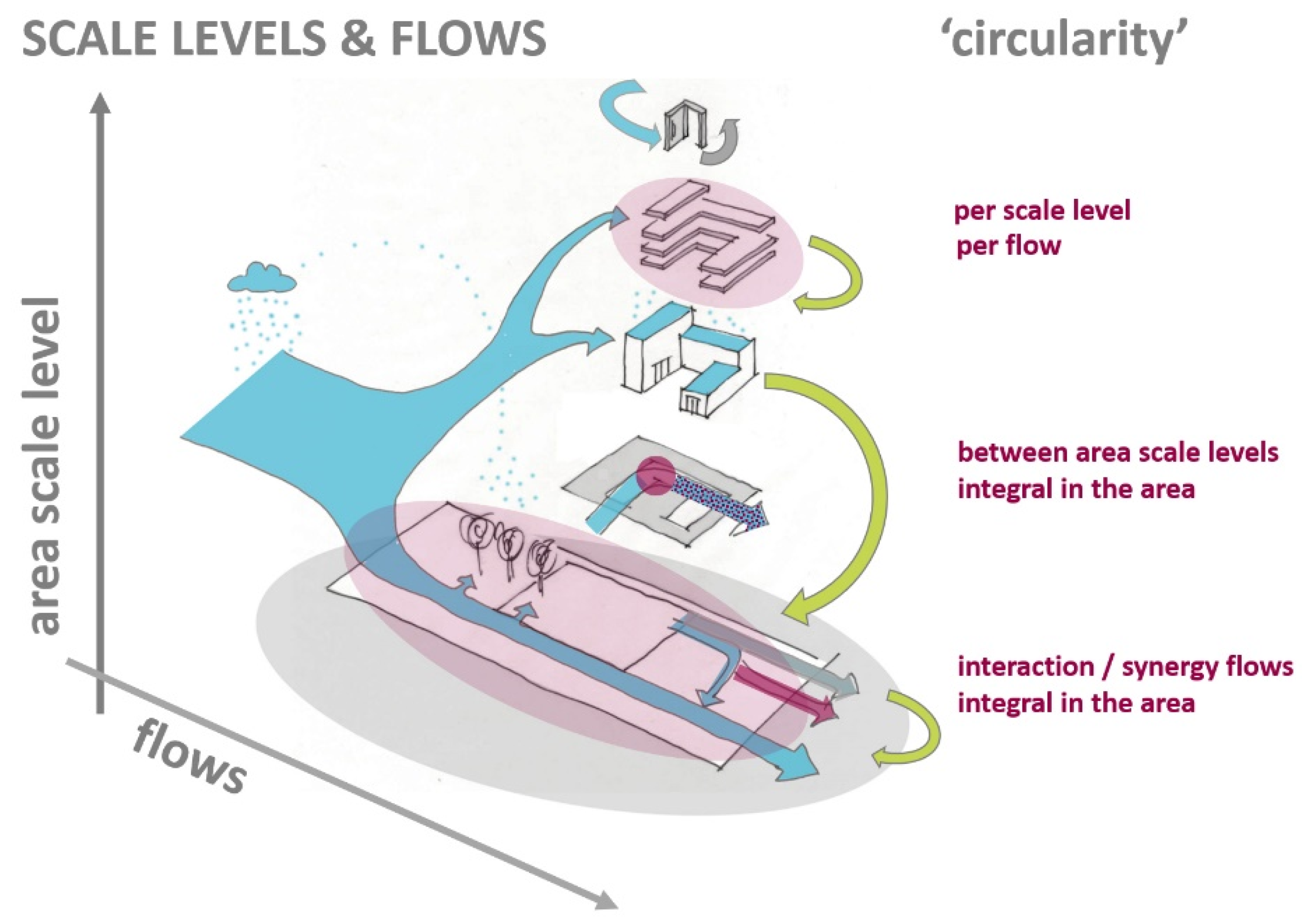
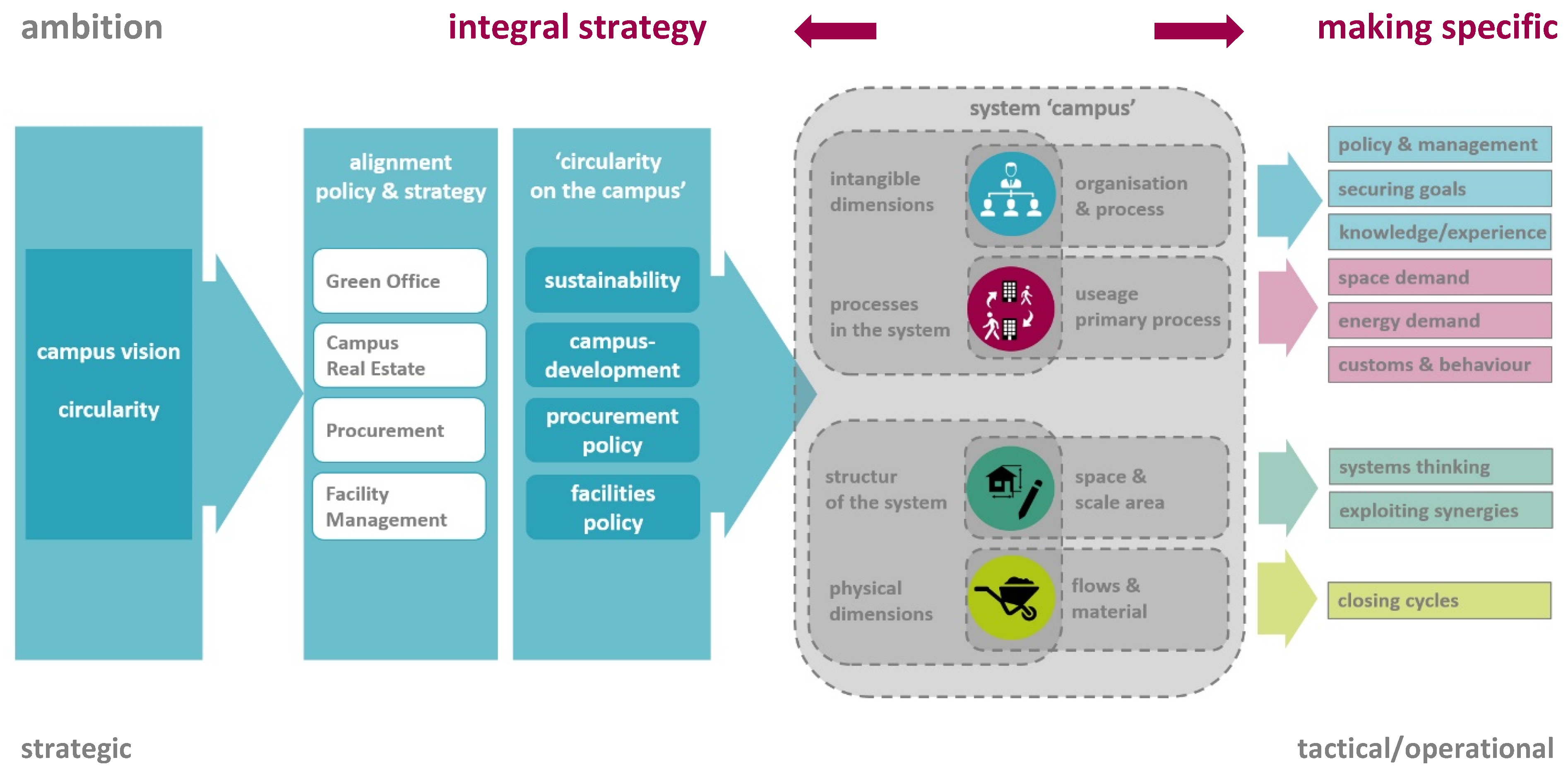
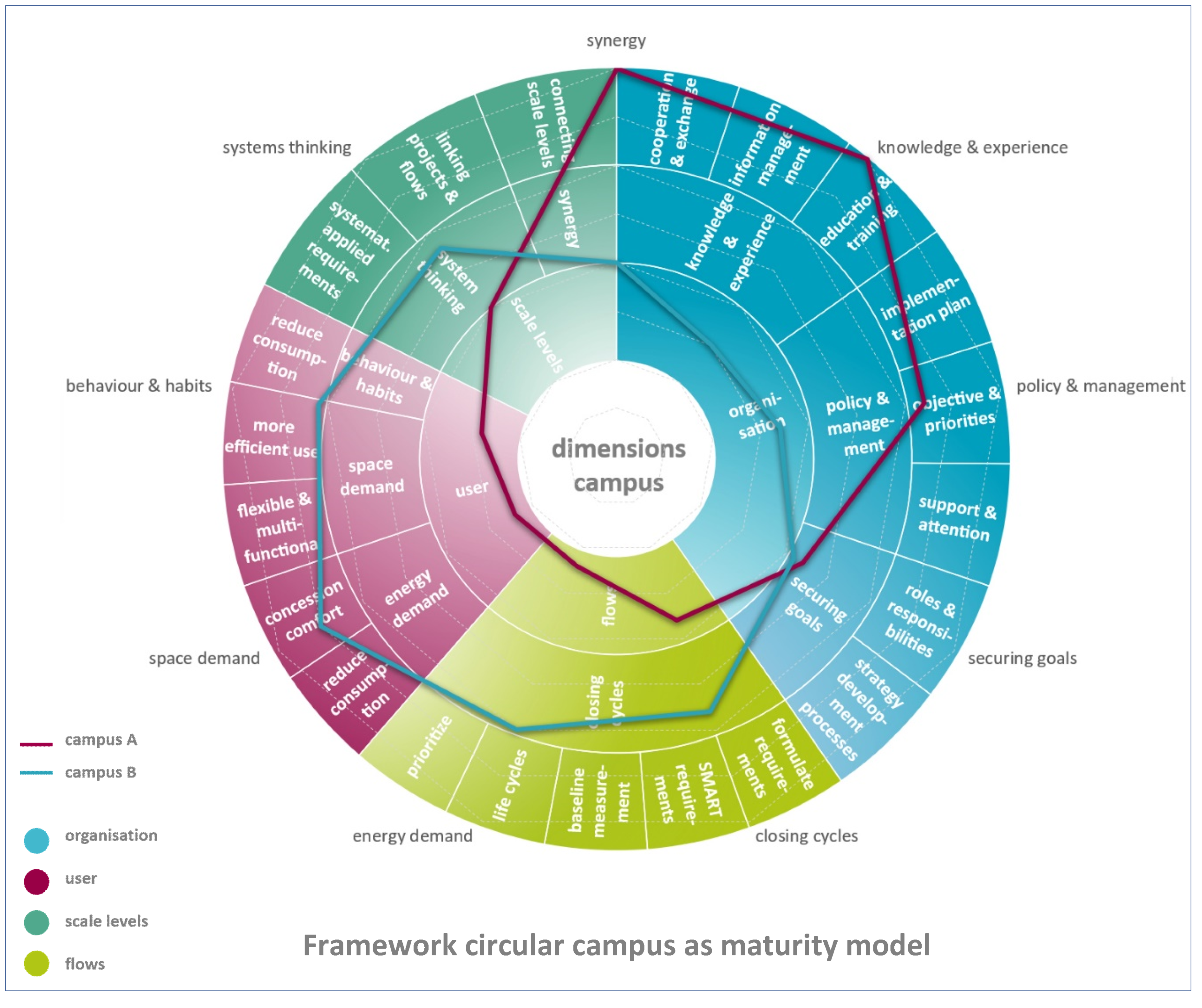
© 2019 by the authors. Licensee MDPI, Basel, Switzerland. This article is an open access article distributed under the terms and conditions of the Creative Commons Attribution (CC BY) license (http://creativecommons.org/licenses/by/4.0/).
Share and Cite
Hopff, B.; Nijhuis, S.; Verhoef, L.A. New Dimensions for Circularity on Campus—Framework for the Application of Circular Principles in Campus Development. Sustainability 2019, 11, 627. https://doi.org/10.3390/su11030627
Hopff B, Nijhuis S, Verhoef LA. New Dimensions for Circularity on Campus—Framework for the Application of Circular Principles in Campus Development. Sustainability. 2019; 11(3):627. https://doi.org/10.3390/su11030627
Chicago/Turabian StyleHopff, Birgit, Steffen Nijhuis, and Leendert A. Verhoef. 2019. "New Dimensions for Circularity on Campus—Framework for the Application of Circular Principles in Campus Development" Sustainability 11, no. 3: 627. https://doi.org/10.3390/su11030627
APA StyleHopff, B., Nijhuis, S., & Verhoef, L. A. (2019). New Dimensions for Circularity on Campus—Framework for the Application of Circular Principles in Campus Development. Sustainability, 11(3), 627. https://doi.org/10.3390/su11030627




